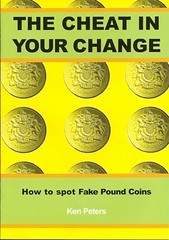
PREV ARTICLE
NEXT ARTICLE
FULL ISSUE
PREV FULL ISSUE
BOOK REVIEW: THE CHEAT IN YOUR CHANGE
I have a lot of personal interest in the Cheat in Your Change booklet. When I lived in London in 2007 I often wondered how many of the pound coins I used were counterfeit. They all seem so worn I guessed it would be easy to circulate counterfeits, and I turned out to be right. Here's some text from the start of the booklet (thanks, Ken!): Since the first pound coin of 1983, three different portraits of the Queen have appeared, plus five different edge markings and twelve different reverse designs. This is not something that forgers seem to be aware of or particularly bothered about, resulting in thousands of fakes being made with wrong pairings of date, bust, reverse design or edge legend.
HOW TO SPOT FAKE POUND COINS
There are three main types of forgery. The lead (sometimes tin) alloy efforts just mentioned, nicknamed by the Royal Mint "garden shed" fakes, because that is where many small-scale 'enterprises' have been located. The second type - hard metal nickel-brass. The third type has a lead core in a thick 'crust' of hard metal, one source of which turns out to be melted down genuine coins. The 8 1/4" x 6" softcovered booklet has 24 pages, counting the covers. The content is divided into 18 concise chapters, starting with the basics: Colour Comparisons, Basic Checking, Edge Checking and Die Axis Deviations. Other tells include Ring (the sound the coin makes when dropped on a hard surface), Touch and even Smell. A section titled "Odd But OK" describes certain genuine and acceptable pound coins that are seldom seen in mainland Britain. While they may look odd to most people, the pound coins issued for use in the Falklands, Gibraltar, Guernsey, Isle of Man, Jersey and St. Helena are all good. Another section details the specifications of genuine Royal Mint one pound coins. My favorite section is the two-page Quick Check photo spread at the center of the booklet. The guide is a handy one-stop reference to the proper combinations of queen's head, reverse design and edge legend for genuine coins. I didn't realize such a book existed or I would have endeavored to pick up a copy in 2007 - it would have been fun to examine my pocket change with the guidebook in hand. I supposed one could assemble quite a collection of different varieties of circulating counterfeits.
For more information or to obtain a copy of the booklet, contact author Ken Peters at kenvoy@hotmail.co.uk.
The Numismatic Bibliomania Society is a non-profit organization promoting numismatic literature. See our web site at coinbooks.org. To submit items for publication in The E-Sylum, write to the Editor at this address: whomren@gmail.com To subscribe go to: https://my.binhost.com/lists/listinfo/esylum All Rights Reserved. NBS Home Page Contact the NBS webmaster 
|
